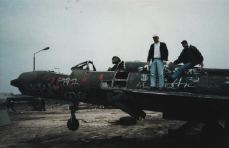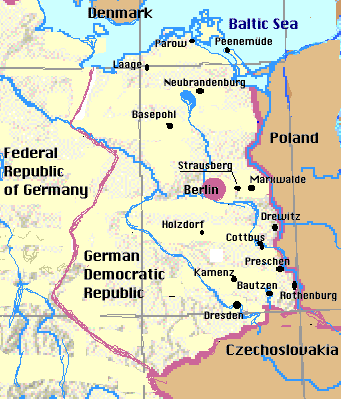 The East German Air Force
The East German Air ForceIntroduction
The Structure and Organization
Fighter Wing 8 "H. Matern"
The Flight Training
Introduction
The East German Air Force, part of the National Peoples Army of the German Democratic Republic, disappeared from the arena on October 3, 1990, the date of the official German reunification.

Just have a look at the sad picture of this vandalized MiG-21 somewhere in Berlin. I wish they would have torched that one like all the other MiG-21s.
The "National Volksarmee" used to be amongst the better armed forces of the Warsaw Pact. Its personnel was very well trained, motivated and compensated. The equipment was rather old and mostly outdated, but relatively well maintained.
That didn't help much when the new owners, the West Germans, came and basically dismantled, destroyed, or sold most of the East German material. Only a few aircraft were taken over by the Luftwaffe; mainly transport airplanes and helicopters of the Mi-2 and Mi-8 type. The MiG-29 was the only fighter to be taken over by the West Germans. It would have been really stupid not to accept a fighter jet that was capable of outperforming everything they had. It now is the most maneuverable fighter in the Luftwaffe's arsenal and will be until the arrival of the Eurofighter 2000, or what ever they call it.
The East German Air Force was entirely organized by Soviet standards which should have been very helpful when flying with the Russians in exercises. The truth was East German pilots never spoke to Russian controllers, except for those very few occasions when we were scheduled to land at one of their airports. We some times flew against each other in exercises, blue against red. The Warsaw Pact wasn't even close to what the NATO is in the West. The average East German pilot didn't speak Russian well enough to do that. The ones that spoke reasonable Russian had taken courses at the Russian Air Force Academy in Moscow to become squadron or wing commanders. They routinely did the communicating between the Russian Command and the German troops. The Soviet's security understanding prohibited an effective way of working together.
Each base had fixed days for flying. Fighter wing 8, the one where the author flew, was allowed to fly on Mondays, Wednesdays and Fridays. The other days were flight preparation days. Normal flight days were done from the flight line. Once a month we flew out of the hardened shelters. A flight preparation day started with physical training for the pilots followed by the post flight briefing of the last flight day. A meeting of the entire wing (usually 3 squadrons of about 16 to 20 pilots) where the commander in charge set the priorities and goals for the next flight , was then followed by the personal preparation of each pilot together with his flight. No pilot was allowed to fly next day unless he past a quizzing by their flight leaders and the flight leaders by the the squadron officer for flight training.
The flight day began with a weather reconnaissance flight of the commander in charge with the next highest officer. All other pilots meanwhile did a sort of cockpit training inside the planes and preflight preparation/discussion in their flights. A high speed low level fly-by by the weather MiG-21UM usually indicated that we were to use the first (good weather) variant of our schedules. Mid to high level clouds meant second variant (low level VFR flight if the ceiling was high enough and intercepting in the clouds). Really low clouds with a top of less than 1000 meters allowed us to fly aerobatics and dogfights above the clouds combined with supersonic intercepts in the stratosphere.
A preflight briefing by the commander on weather conditions was next. A normal flight day was 6 hours of active flying with a second shift doing the same, using the same airplanes. If we had to combine all of our effort, we would fly only one shift of up to eight hour.
The average flight time for our pilots was 100 hours per year. That's only half of what a NATO pilot gets. However, every flight was an effective mission from the training syllabus with no x-country flying (except being the target for a fellow pilot) or other bogus flights involved.
Two days of every month were reserved for political education, the orgasms of our political officers. We called it "red light", or something "better than no sleep at all".
The third squadron of each wing was the trainee flight. They did the most flying up to 120 hours annually. The second squadrons concentrated their efforts on air-to-ground attacks. The first squadrons consisted of the best pilots, the eagles, or cracks, or pros. The were the champions of intercepting and dogfighting. Pilots of the second and first squadron shared the commitment for the quick reaction or alert unit. All pilots to serve there had to be fully trained in all weather conditions up to the planes weather minimums at day and night. Those pilot would only get between 60 to 80 hour of flight time a year. Every fighter wing had to have two pilots with three planes in the alert unit at any time. We got very mad when we found out other the change that the Luftwaffe in the West usually locked everything up at Friday noon and went home. We served 24 hours a day, 365 days a year and they were sitting by the Christmas trees drinking beer. That for sure wasn't fair. It wasn't the only lie either that our leaders told us.
But is still was a fun job to kick the tire and light the fire.
The Structure / Organization of the LSK/LV
Abbreviations:
FAG........Fighter Pilot Training Wing
FDK........Target Towing Flight
HAG........Helicopter Pilot Training Wing
HSFA......Command and Observation Helicopter Squadron
JBG.........Fighter Bomber Wing
JG...........Fighter Wing
KHG........Combat Helicopter Wing
MFG........Naval Air Wing
MHG........Naval Helicopter Wing
NVA........National People's Army
TAFS.......Tactical Air Reconnaissance Squadron
TAS.........Air Transport Training Squadron
THG.........Air Transport Helicopter Squadron
TG...........Air Transport Wing
VFK.........Air Liaison Flight
Air Force / Air Defense Command at Strausberg AFB Unit Base Squadrons Aircraft Type Number 1. Air Defense Division at Cottbus AFB JG-1 Holzdorf 2/1 MiG-21MF/SPS/UM 35/21/9 JG-3 Preschen 2/1 MIG-29A/UB/MIG-21MF/UM 20/4/12/3 JG-7 Drewitz 2 MiG-21M/UM 27/5 JG-8 Marxwalde 2/1 MiG-21SAU-BIS/-21BIS/UM 28/13/8 VFK-1 Cottbus - AN-2/Zlin-43 2/3 3. Air Defense Division at Neubrandenburg AFB JG-2 Neubrandenburg 2/1 MiG-21M/SPS/UM 31/12/8 JG-9 Peenemünde 2/1 MiG-23ML/MF/UB 28/9/6 FDK-33 Peenemünde - L-39V/ZO 2/2 VFK-3 Neubrandenburg - AN-2/Zlin-43 2/2 Fighter Bomber and Air Transport Command at Cottbus AFB JBG-37 Drewitz 2 MiG-23BN/UB 18/3 JBG-77 Laage 2 Su-22M-4/UM-3K 22/4 TAFS-87 Preschen 1 MiG21M/UM 13/3 TAFS-47 Drewitz 1 MiG-21M/UM 12/2 THG-34 Brandenburg 1/1 Mi-8T/Mi-8S 17/2 TG-44 Marxwalde 2 IL-62/TU-154/TU-134A/Mi-8S 2/1/5/6 TS-24 Dresden 2 AN-2/L-410UVP/Zlin-43 8/4/4 VFS-14 Strausberg 1 AN-2/L-410UVP/Zlin-43 8/4/4 Air Force Traing Command at Kamenz AFB FAG-15 Rothenburg 2 MiG-21SPS/U/US/UM 26/13/13/3 FAG-25 Bautzen 3 L-39ZO 48 HAG-35 Brandenburg 2 Mi-2/Mi-8S/T 17/11/6 TAS-45 Kamenz 1 AN-2/L-410T/Zlin-43 12/8/3 Army Air Command at Cottbus AFB KHG-3 Cottbus 2 Mi-24D/Mi-8TB 19/16 HSFA-3 Cottbus - Mi-2/Mi8S/Mi-9 4/1/4 KHG-5 Basepohl 2/1 Mi-24D/P/Mi-8TB 20/12/10 HSFA-5 Basepohl - Mi-2/8S/9 4/1/4 Navy Air Command at Parow AB MHG-18 Parow 1/1 Mi-8S/T/TB/Mi-14BT/PL 1/2/11/6/10 MFG-28 Laage 2 Su-22M-4/Su-22UM-3K 23/4

Still under 










Abbreviations:
FAG........Fighter Pilot Training Wing
FDK........Target Towing Flight
HAG........Helicopter Pilot Training Wing
HSFA......Command and Observation Helicopter Squadron
JBG.........Fighter Bomber Wing
JG...........Fighter Wing
KHG........Combat Helicopter Wing
MFG........Naval Air Wing
MHG........Naval Helicopter Wing
NVA........National People's Army
TAFS.......Tactical Air Reconnaissance Squadron
TAS.........Air Transport Training Squadron
THG.........Air Transport Helicopter Squadron
TG...........Air Transport Wing
VFK.........Air Liaison Flight
Air Force / Air Defense Command at Strausberg AFB Unit Base Squadrons Aircraft Type Number 1. Air Defense Division at Cottbus AFB JG-1 Holzdorf 2/1 MiG-21MF/SPS/UM 35/21/9 JG-3 Preschen 2/1 MIG-29A/UB/MIG-21MF/UM 20/4/12/3 JG-7 Drewitz 2 MiG-21M/UM 27/5 JG-8 Marxwalde 2/1 MiG-21SAU-BIS/-21BIS/UM 28/13/8 VFK-1 Cottbus - AN-2/Zlin-43 2/3 3. Air Defense Division at Neubrandenburg AFB JG-2 Neubrandenburg 2/1 MiG-21M/SPS/UM 31/12/8 JG-9 Peenemünde 2/1 MiG-23ML/MF/UB 28/9/6 FDK-33 Peenemünde - L-39V/ZO 2/2 VFK-3 Neubrandenburg - AN-2/Zlin-43 2/2 Fighter Bomber and Air Transport Command at Cottbus AFB JBG-37 Drewitz 2 MiG-23BN/UB 18/3 JBG-77 Laage 2 Su-22M-4/UM-3K 22/4 TAFS-87 Preschen 1 MiG21M/UM 13/3 TAFS-47 Drewitz 1 MiG-21M/UM 12/2 THG-34 Brandenburg 1/1 Mi-8T/Mi-8S 17/2 TG-44 Marxwalde 2 IL-62/TU-154/TU-134A/Mi-8S 2/1/5/6 TS-24 Dresden 2 AN-2/L-410UVP/Zlin-43 8/4/4 VFS-14 Strausberg 1 AN-2/L-410UVP/Zlin-43 8/4/4 Air Force Traing Command at Kamenz AFB FAG-15 Rothenburg 2 MiG-21SPS/U/US/UM 26/13/13/3 FAG-25 Bautzen 3 L-39ZO 48 HAG-35 Brandenburg 2 Mi-2/Mi-8S/T 17/11/6 TAS-45 Kamenz 1 AN-2/L-410T/Zlin-43 12/8/3 Army Air Command at Cottbus AFB KHG-3 Cottbus 2 Mi-24D/Mi-8TB 19/16 HSFA-3 Cottbus - Mi-2/Mi8S/Mi-9 4/1/4 KHG-5 Basepohl 2/1 Mi-24D/P/Mi-8TB 20/12/10 HSFA-5 Basepohl - Mi-2/8S/9 4/1/4 Navy Air Command at Parow AB MHG-18 Parow 1/1 Mi-8S/T/TB/Mi-14BT/PL 1/2/11/6/10 MFG-28 Laage 2 Su-22M-4/Su-22UM-3K 23/4

Still under 










| Air Force / Air Defense Command at Strausberg AFB | ||||
|---|---|---|---|---|
| Unit | Base | Squadrons | Aircraft Type | Number |
| 1. Air Defense Division at Cottbus AFB | ||||
| JG-1 | Holzdorf | 2/1 | MiG-21MF/SPS/UM | 35/21/9 |
| JG-3 | Preschen | 2/1 | MIG-29A/UB/MIG-21MF/UM | 20/4/12/3 |
| JG-7 | Drewitz | 2 | MiG-21M/UM | 27/5 |
| JG-8 | Marxwalde | 2/1 | MiG-21SAU-BIS/-21BIS/UM | 28/13/8 |
| VFK-1 | Cottbus | - | AN-2/Zlin-43 | 2/3 |
| 3. Air Defense Division at Neubrandenburg AFB | ||||
| JG-2 | Neubrandenburg | 2/1 | MiG-21M/SPS/UM | 31/12/8 |
| JG-9 | Peenemünde | 2/1 | MiG-23ML/MF/UB | 28/9/6 |
| FDK-33 | Peenemünde | - | L-39V/ZO | 2/2 |
| VFK-3 | Neubrandenburg | - | AN-2/Zlin-43 | 2/2 |
| Fighter Bomber and Air Transport Command at Cottbus AFB | ||||
| JBG-37 | Drewitz | 2 | MiG-23BN/UB | 18/3 |
| JBG-77 | Laage | 2 | Su-22M-4/UM-3K | 22/4 |
| TAFS-87 | Preschen | 1 | MiG21M/UM | 13/3 |
| TAFS-47 | Drewitz | 1 | MiG-21M/UM | 12/2 |
| THG-34 | Brandenburg | 1/1 | Mi-8T/Mi-8S | 17/2 |
| TG-44 | Marxwalde | 2 | IL-62/TU-154/TU-134A/Mi-8S | 2/1/5/6 |
| TS-24 | Dresden | 2 | AN-2/L-410UVP/Zlin-43 | 8/4/4 |
| VFS-14 | Strausberg | 1 | AN-2/L-410UVP/Zlin-43 | 8/4/4 |
| Air Force Traing Command at Kamenz AFB | ||||
| FAG-15 | Rothenburg | 2 | MiG-21SPS/U/US/UM | 26/13/13/3 |
| FAG-25 | Bautzen | 3 | L-39ZO | 48 |
| HAG-35 | Brandenburg | 2 | Mi-2/Mi-8S/T | 17/11/6 |
| TAS-45 | Kamenz | 1 | AN-2/L-410T/Zlin-43 | 12/8/3 |
| Army Air Command at Cottbus AFB | ||||
| KHG-3 | Cottbus | 2 | Mi-24D/Mi-8TB | 19/16 |
| HSFA-3 | Cottbus | - | Mi-2/Mi8S/Mi-9 | 4/1/4 |
| KHG-5 | Basepohl | 2/1 | Mi-24D/P/Mi-8TB | 20/12/10 |
| HSFA-5 | Basepohl | - | Mi-2/8S/9 | 4/1/4 |
| Navy Air Command at Parow AB | ||||
| MHG-18 | Parow | 1/1 | Mi-8S/T/TB/Mi-14BT/PL | 1/2/11/6/10 |
| MFG-28 | Laage | 2 | Su-22M-4/Su-22UM-3K | 23/4 |

